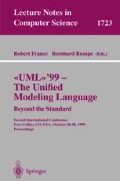Abstract
UML provides a variety of diagram types for specifying both the structure and the behavior of a system. During the development process, models specified by use of these diagram types have to be transformed into corresponding code. In the past, mainly class diagrams and state diagrams have been considered for an automatic code generation. In this paper, we focus on collaboration diagrams. As an important prerequisite for a consistent transformation into Java code, we first provide methodical guidelines on how to deploy collaboration diagrams to model functional behavior. This understanding yields a refined meta model and forms the base for the definition of a transformation algorithm. The automatically generated Java code fragments build a substantial part of the functionality and prevent the loss of important information during the transition from a model to its implementation.
Access this chapter
Tax calculation will be finalised at checkout
Purchases are for personal use only
Preview
Unable to display preview. Download preview PDF.
References
Ali, J., Tanaka, J.: Generating executable code from the dynamic model of OMT with concurrency. In: Proc. IASTED International Conference on Software Engineering (SE’97), San Francisco, 1997, pp. 291–297
Ali, J., Tanaka, J.: Implementation of the dynamic behavior of object oriented systems. In: Integrated Design and Process Technology (IDPT), Vol. 4, Society for Design and Process Science, 1998, pp. 281–288
Engels, G., Heckel, R., Taentzer, G., Ehrig, H.: A view-oriented approach to system modelling using graph transformations. In Jazayeri, M., Schauer, H. (eds.): Proceedings European Software Engineering Conference (ESEC’97), Zürich, LNCS 1301, Springer, 1997, pp. 327–343
Engels, G., Hücking, G., Sauer, S., Wagner, A.: UML Collaboration Diagrams and Their Transformation to Java. Technical Report TR-RI-99-208, University of Paderborn, 1999
Harel, D., Gery, E.: Executable Object Modeling with Statecharts. IEEE Computer, 30 (July 1997) 31–42
Hücking, R.: UML Collaboration Diagrams and Their Transformation to Java (in German). Master’s Thesis, University of Paderborn, September 1998
Lieberherr, K.: Adaptive Object-Oriented Software: The Demeter Method with Propagation Patterns. PWS Publishing Company, Boston MA, 1996
OMG: UML Notation Guide, Version 1.1. The Object Management Group, Document ad/97-08-05, Framingham MA, 1997
OMG: UML Semantics. Version 1.1. The Object Management Group, Document ad/97-08-04, Framingham MA, 1997
Rational Rose 98. Rational Software Corporation, Cupertino CA, 1998
Rhapsody. Version 2.1. I-Logix, Andover MA, 1998
Rumbaugh, J., Blaha, M., Premerlani, W., Eddy, F., Lorensen, W.: Object-Oriented Modelling and Design. Prentice-Hall, 1991
Rumbaugh, J., Jacobson, I., Booch, G.: The Unified Modeling Language Reference Manual. Addison-Wesley, Reading MA, 1999
Sangal, N., Farrel, E., Lieberherr, K.: Interaction Graphs: Object interaction specifications and their compilation to Java. Technical Report NU-CCS-98-11, Northeastern University, Oct. 1998
Statemate MAGNUM. Release 1.2. I-Logix, Andover MA, 1999
Structure Builder. Version 3.1.5. Tendril Software Inc., Westford MA, 1999
A. van Wijngaarden: The Generative Power of Two-Level Grammars. In J. Loeckx (ed.): Automata, Languages and Programming, 2nd Colloquium, University of Saarbrücken, 1974. LNCS 14, Springer, 1974, pp. 9–16
Author information
Authors and Affiliations
Editor information
Editors and Affiliations
Rights and permissions
Copyright information
© 1999 Springer-Verlag Berlin Heidelberg
About this paper
Cite this paper
Engels, G., Hücking, R., Sauer, S., Wagner, A. (1999). UML Collaboration Diagrams and Their Transformation to Java. In: France, R., Rumpe, B. (eds) «UML»’99 — The Unified Modeling Language. UML 1999. Lecture Notes in Computer Science, vol 1723. Springer, Berlin, Heidelberg. https://doi.org/10.1007/3-540-46852-8_34
Download citation
DOI: https://doi.org/10.1007/3-540-46852-8_34
Published:
Publisher Name: Springer, Berlin, Heidelberg
Print ISBN: 978-3-540-66712-4
Online ISBN: 978-3-540-46852-3
eBook Packages: Springer Book Archive

